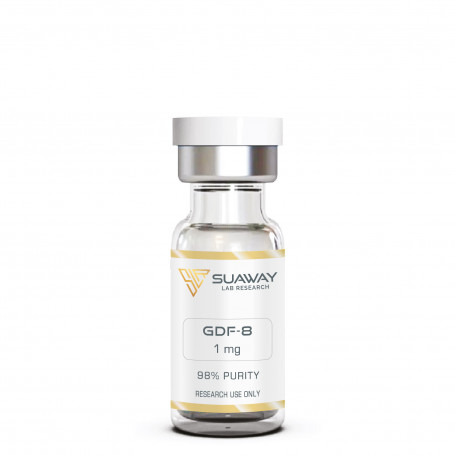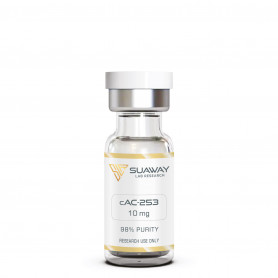GDF-8 – 1 mg
The propeptide known as GDF-8 has the specific purpose of inhibiting the myostatin. It has been shown to have the effects that are listed below:
- Enhancement muscular regeneration and in healing injuries
- Enhancement of body capacity to regenerative
- Increase of myofiber hypertrophy
Description
STRUCTURE
Sequence:MQKLQLCVYIYLFMLIVAGPVDLNENSEQKENVEKEGLCNACTWRQNTKSSRIEAIKIQILSKLRLETAPNISKDVIRQLLPKAPPLRELIDQYDVQRDDSSDGSLEDDDYHATTETIITMPTESDFLMQVDGKPKCCFFKFSSKIQYNKVVKAQLWIYLRPVETPTTVFVQILRLIKPMKDGTRYTGIRSLKLDMNPGTGIWQSIDVKTVLQNWLKQPESNLGIEIKALDENGHDLAVTFPGPGEDGLNPFLEVKVTDTPKRSRRDFGLDCDEHSTESRCCRYPLTVDFEAFGWDWIIAPKRYKANYCSGECEFVFLQKYPHTHLVHQANPRGSAGPCCTPTKMSPINMLYFNGKEQIIYGKIPAMVVDRCGCS
Molecular Weight: 42750 Da
Protein purity: Greater than 98%
Other details: No TFA Salt
Storage: Lyophilized peptide must be stored at -20°C and peptide solution at 4°C.
GDF-8 has low oral and excellent subcutaneous bioavailability.
.
DESCRITPION
The propeptide known as GDF-8 (Human Growth/Differentiation Factor 8) has the specific purpose of inhibiting the myostatin that occurs in the body naturally. Myostatin is a vital protein that inhibits the expansion and maturation of muscle cells and plays a role in preventing these processes. Animals such as the Belgian blue bull create less myostatin than other breeds of cow, and this is responsible for the breed's exceedingly slim, hyper sculpted and ultra-muscular physique owing to an increased amount of muscle fibers.
Myostatin cannot be activated because GDF-8 prevents it from binding to its receptors. These receptors normally function to switch off muscle growth when myostatin is bound, but because the binding is blocked by GDF-8, muscle growth can continue unrestricted. GDF-8 works by binding myostatin so that it cannot be activated and preventing it from binding to its receptors. It has been shown that a lack of myostatin results in considerable increases in the amount of muscle mass that is present in both humans and animals. It has been shown that the absence of myostatin in bone results in an increase in bone mineral density.
In a model of tissue injury, animal experiments that employed GDF-8 revealed improvements in muscle and bone healing. These results imply that the peptide may be used to repair injured muscle and bone. Research has also been done on the peptide to see whether or not it might be used to treat Duchene’s muscular dystrophy, a condition that causes muscle atrophy. In the research, the peptide was shown to be a possible pharmacological method for treating disorders related to muscle wasting.
In conclusion, recent research found that mice that had their myostatin signaling inhibited by the use of overexpression of the myostatin propertied had exceptional levels of muscle development. The same research that demonstrated that the peptide could cause muscle development also demonstrated that the muscle could generate normal amounts of force after it had been treated with the peptide.
A fibula osteotomy model with associated damage to lateral compartment muscles in mice was used in a study to test the hypothesis that blocking active myostatin with systemic injections of a recombinant myostatin propeptide would improve muscle and bone repair. The results of the study were positive, indicating that the hypothesis was correct. After undergoing a fibula osteotomy, mice were randomly divided into two treatment groups: those receiving either vehicle (saline) or recombinant myostatin propeptide (GDF-8) (20 mg/kg). The mice each got one injection on the day of surgery, another injection five days after surgery, and a third injection ten days following surgery. 15 days following the osteotomy surgery, mice were killed. Micro-computed tomography (micro-CT) and histologic analysis of the fracture callus were used to evaluate the degree of bone regeneration.
After receiving three propeptide (GDF-8) injections over 15 days, body mass was raised by 7%, and there was an approximately 20% increase in muscle mass. Micro-CT analysis of the osteotomy site shows that by 15 days post osteotomy, bony callus tissue was observed bridging the osteotomy gap in 80% of the propeptide -treated mice, but in only 40% of the control (vehicle)-treated mice. This was determined by comparing the number of mice that had bony callus tissue observed between the propertied-treated mice and the vehicle-treated mice. The results of the micro-CT quantification demonstrate that the bone volume of the fracture callus was raised by more than 30% as a result of the propeptide therapy. Additionally, the increase in bone volume was accompanied by a considerable increase in cartilage area. The use of propeptide resulted in a significant reduction in the amount of fibrous tissue present at the wound site, while simultaneously leading to a 20% rise in the proportion of muscle to fibrous tissue.
According to the findings of the research, inhibiting the signaling of myostatin in the wounded limb promotes faster fracture healing and more effective muscle regeneration. Based on these findings, it seems that myostatin inhibitors may be useful for speeding up the healing process of wounds sustained as a result of orthopedic trauma and extremities damage.
REFERENCES
Man-Shiow Jiang et al., "Characterization and identification of the inhibitory domain of GDF-8 propeptide" [ScienceDirect]
Y. Elkina et al., "The role of myostatin in muscle wasting: an overview" [PubMed]
H. Collins-Hooper et al., "Propeptide-Mediated Inhibition of Myostatin Increases Muscle Mass Through Inhibiting Proteolytic Pathways in Aged Mice" [The Journal of Gerontology]
N. Oksbjerg et al., "In Belgian Blue and Piedmontese breeds of cattle there are various mutations in the MSTN gene that lead to the secretion of nonfunctional myostatin" [ScienceDirect]
S. Bogdanovich et al., "Myostatin propeptide-mediated amelioration of dystrophic pathophysiology" [PubMed]
M.W. Hamrick et al., "Recombinant Myostatin (GDF-8) Propeptide Enhances the Repair and Regeneration of Both Muscle and Bone in a Model of Deep Penetrant Musculoskeletal Injury" [ResearchGate]
X. Zheng et al., "Regulatory Role and Potential Importance of GDF-8 in Ovarian Reproductive Activity" [PubMed]
Se-Jin Lee "Targeting the myostatin signaling pathway to treat muscle loss and metabolic dysfunction" [PubMed]
M.N Elkasrawy et al., "Myostatin (GDF-8) as a key factor linking muscle mass and bone structure" [PubMed]
DISCLAIMER
This product is intendend for lab research and development use only. These studies are performed outside of the body. This product is not medicines or drugs and has not been approved by the FDA or EMA to prevent, treat or cure any medical condition, ailment or disease. Bodily introduction of any kind into humans or animals is strictly forbidden by law. This product should only be handled by licensed, qualified professionals.
All product information provided on this website is for informational and educational purposes only.












